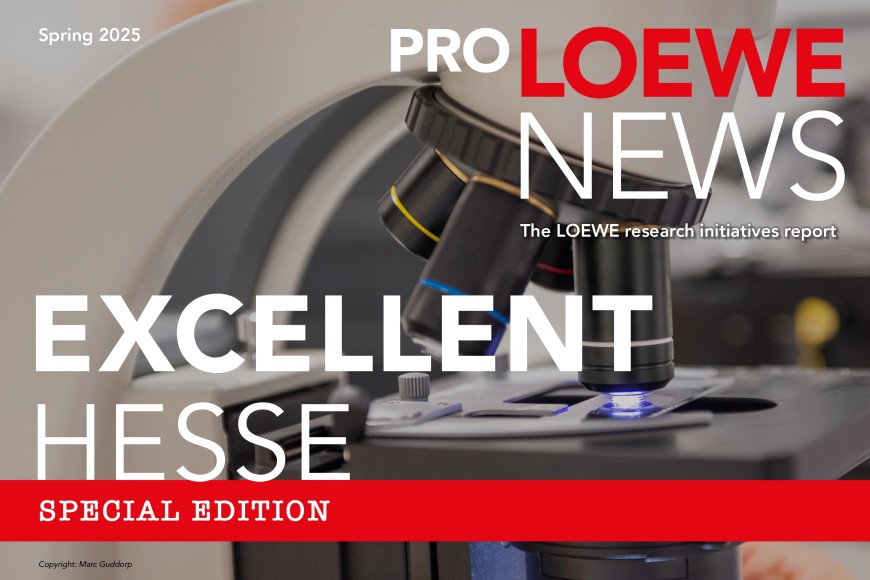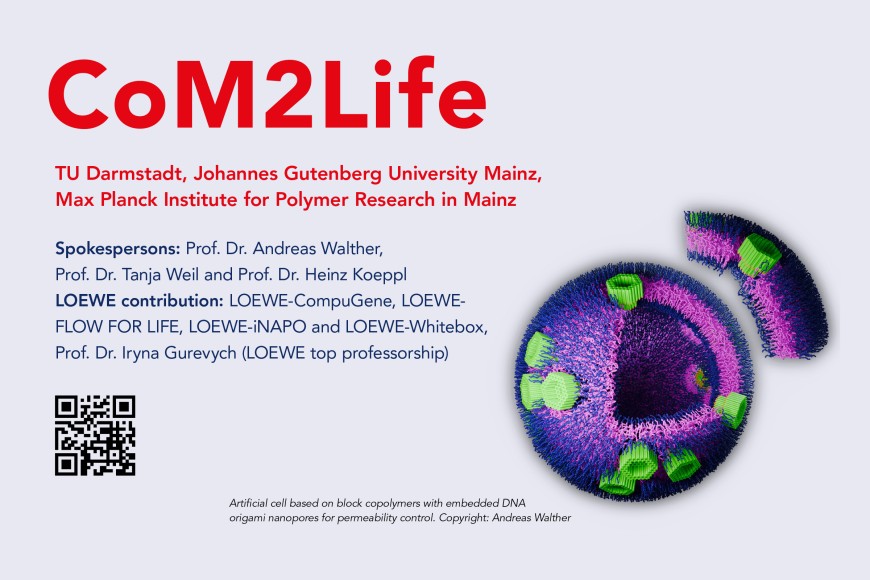Special edition of PROLOEWE News on the Excellence Initiative
The decision in the Excellence Initiative will be made soon
2025/05/05
On Thursday, May 22, 2025, at around 5 p.m., the Clusters of Excellence that will be funded in the future will be announced. Among them is CoM2Life – Communicating Biomaterials – in which the Center for Synthetic Biology at TU Darmstadt is involved together with Johannes Gutenberg University Mainz and the Max Planck Institute for Polymer Research in Mainz. All Hessian projects are currently being presented in a special edition of PROLOEWE News.

The Excellence Strategy is an important agreement between the federal and state governments that aims to sustainably promote cutting-edge research and strengthen the international competitiveness of German universities – and thus also of Germany as a business location. It is the successor to the Excellence Initiative and is divided into two central funding lines: clusters of Excellence and Universities of Excellence.
Clusters of Excellence funding line. Clusters of Excellence are selected and assessed on the basis of scientific selection procedures. These procedures are carried out by the German Research Foundation (DFG) and the German Council of Science and Humanities on behalf of the federal and state governments. The aim is to promote internationally competitive research fields at universities and in university consortia, whereby up to 70 clusters can be funded with between 3 and 10 million euros per year. For the first funding phase of initially seven years (starting in 2019), a total of a total of 57 clusters of excellence were selected.
Hessian successes. “CPI”, a Hessian project, and “POLiS”, a project with Hessian participation, are also among the clusters of excellence in the first funding phase!
Future prospects: On February 1, 2024, the panel of experts selected 41 outlines to submit for the second funding phase from 2026. Five more projects qualified here: “RAI”, “TAM”, “CoM2Life”, “MC4” and “SCALE”. Together with “CPI” and “POLiS”, this makes seven Hessian projects or projects with Hessian participation that are already excellent or have a good chance of becoming excellent.
The long road to a cluster of excellence – LOEWE provides support. Clusters of excellence are an important part of the long-term strategic and thematic planning of universities. The last call for clusters of excellence took place in December 2022. From the very beginning, promising Hessian initiatives were supported by the state of Hesse with additional funding for the development of cluster projects. The draft proposals for the first selection round of new clusters of excellence were submitted to the DFG in May 2023 and the results of the review were announced in February 2024. The selected projects in the second round had a good six months to prepare a full proposal. Existing clusters of excellence submitted a follow-up application at the same time. The work on the full proposals is characterized by intensive professional and very close cooperation in the consortia, each supported by 20-25 high-rankings researchers as well as the respective university management. The full proposals submitted by the cluster of Excellence candidates in August 2024 were reviewed in detail by the DFG in Bonn between October 2024 and February 2025. To this end, the clusters and the participating university management teams faced international expert groups in presentations and interviews lasting several hours. The decision on funding as a cluster of Excellence will be made in May 2025; the actual funding of the selected projects will then start on January 1, 2026 for a period of seven years.
What comes next: University of Excellence. In addition to the clusters of Excellence, the Universities of Excellence funding line enables individual universities or consortia to be strengthened. The prerequisite for this is to have successfully acquired at least two clusters of excellence (three in the case of consortia). The Rhine-Main Universities of Frankfurt, Mainz (in Rhineland-Palatinate, however, part of the Rhine-Main Network) and Darmstadt as well as the Universities of Marburg and Giessen have promising chances of applying – whether individually or jointly.
The importance of LOEWE for the Excellence Strategy. For the Hessian initiatives, the support of the state government within the framework of the LOEWE program is a decisive start-up aid. On the one hand, the start-up funding for the promising initiatives enables the consolidation of scientific integration within the respective consortia beyond the existing equipment of the participating institutes, thereby further increasing the scientific weight of the initiatives. On the other hand, they also create a framework for developing the formal and structural success factors of long-term research initiatives, which are not easy to organize in the day-to-day business of universities. Finally, the awarding of LOEWE professorships substantially improves the structural set-up of the initiatives and thus in turn increases the overall chances of the respective applications. But the influence of LOEWE funding on the clusters begins even before this. As can be clearly seen on the following pages, the proportion of scientists who have already conducted research in LOEWE projects is high. Overall, the importance of the LOEWE program on the path to research excellence in Hesse cannot be overestimated.
The significance for Hesse. With the Excellence Strategy and successfully acquired clusters of Excellence, Hesse is becoming a central player in top-level research in Germany. The combination of innovative projects and strategic partnerships lays the foundation for forward-looking scientific development.
CoM2Life
The vision of the Convergence Center for Life-Like Soft Materials and Biological Systems, “CoM2Life“ – Communicating Biomaterials is to revolutionize the field of soft biomaterials by integrating principles from living systems into synthetic materials to enable bidirectional communication and continuous interaction with living biological systems. Our approach combines chemistrycentered biomaterials design and synthetic biology-centered design of regulatory circuits, resulting in biomaterials that exhibit life-like properties such as signal sensing, processing, and actuation. This breakthrough towards biomaterials with an ‘embodied intelligence’ unlocks new possibilities for interactive crossregulation and adaptive co-development in future generations of biomaterials systems. These advancements are expected to drive breakthroughs in medical research and personalized healthcare in the coming decades. Examples include feedback-regulated drug delivery tissue models that can replace animal testing, metabolic regulation systems for tumor immunotherapy, tissue repair, and the engineering of artificial organs. Communication sciences are also involved to foster trust and understanding in this highly interdisciplinary environment and develop effective communication strategies to address the challenges of misinformation in the world today.

